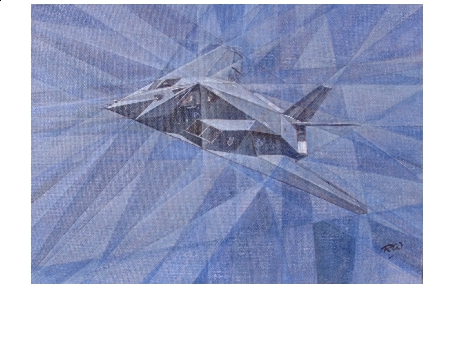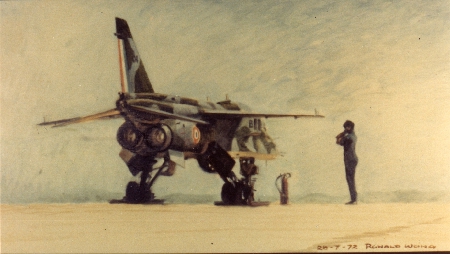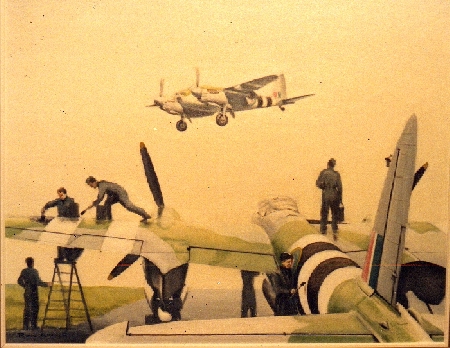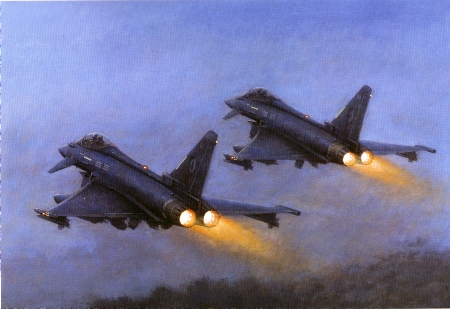|
|
|
Below is the full transcript of my article in the August 2007 issue of Aerial Views. I enjoyed writing it.I find occasionally writing an article a welcome break from/antidote to all that professional painting. The issue of so-called innovation in our art is not new. It has been used by mainstream art and others of a “modernist”or opportunist bent as a stick to beat certain traditional arts with….not just aviation art but marine, motoring, wildlife and other reality-oriented arts which express themselves through truthful depictions of complex and sophisticated subject matter. Writing this response to the CAAA editorial took me back a dozen years, when I was in the position of Exhibition Committee Chairman at the Guild of Aviation Artists and this issue was forcefully brought home to me. Ron ----------------------------------- What's New??In response to Layne's Editorial (AV, May 2007), it may be timely to explore the meaning for us of cliched words like "adventurous" and "innovative", which are such a part of arty rhetoric. Climbing Mt Everest may still be adventurous, being out of the ordinary for most of us, but hardly counts as innovative in the common sense meaning of being new or unprecedented. It has been done too many times, and now often comes down as a PR exercise. Sir Edmund Hilary may be the innovator or pioneer in 1953, going where none had gone before. But the rest are imitators. We artists all doodle and dabble in the confines of our studios. And those little exercises can be fun if not especially illuminating. Pixelate a Spitfire to make of it a cataracted Monet. Stretch the lines of that sleek Concorde in the manner of an astigmatic El Greco. Swirl our brushwork to emulate a drugged Van Gogh*. Confound that crisp F16 with the "primitive" brushwork and raw colours of our young kids. And that F-117 Stealth Fighter is a Godsend for the cubistically-inclined( Fig.1). I've even once seen a painting of a PBY Catalina with both propeller discs on the near side of its fuselage, although in that case the imitation of Picasso may have been unintended! We may be generous enough to label some of this playful cross-dressing as "adventurous"**, but how many would be brazen enough to pass them off as serious examples of "innovation" in our art? And what if some proceeded to make of the adventure a way of life.....let it become their own little boring cookie-cutter, for climbing Mt Everest every other week, assured of the accolades?
Fig 1: Nighthawk: a Studio Exercise.
Fig 2: Engine Test( 1972): Premature Innovation?****
In our Guild of Aviation Artists shows over the decades, aircraft have been painted from every imaginable viewpoint, illuminated in every possible way, again and again, without anyone being consciously "adventurous or "innovative". A basic condition of acceptance is that the work as a whole is not a repetition or copy of some pre-existing image, whether painted or photographed, and in that sense every exhibit is different and novel to begin with. Tail-enders? How many do you want? I could pull out a bunch from my own files( e.g. Fig 2 to 4 ). Where does mere difference stop, and "adventure" begin? And when does that become "innovation"? The big prize-winner for the 2005 Guild exhibition was a Spitfire painted upside down. We're still waiting for someone to bang the gongs over that one. So far, no takers, not even the winner himself. And rightly so. That painting won on its own merits, not on some cheap pretension of novelty. To hang so much of artistic value and hope on such a dubious affectation is a mistake. It is a whopping non sequitur that leads us nowhere, except to those laughable brick piles, pickled cows and unmade beds of mainstream art. We're lucky with just the rare tail-end Charlies.
Fig.3: Invasion Stripes(1972) Like most artists, I am always seeking fresh angles on my subjects, so I am open-minded on what if anything is ultimately progressive/innovative about art. But I suspect that in the long history of art, this recent messianic streak from mainstream art may well be a passing aberration. Just a sad "Me Too" reaction alongside a triumphant Science. Just another blip in a long list of holy falsehoods into which we project our hopes and values. However, I do feel there is something quieter, deeper, and more confident here which we're at risk of missing amidst the clamour of stylistic dodges and fixes. To reduce the whole idea to the familiar posturing exercises also makes the arrogant and silly implication that the rest of us are automatically somehow lacking in our art, just because we are not signalling for accolades with some stylistic equivalent of Pavlov's Bell. May I suggest that uniqueness and freshness of vision is an inherent quality of ANY good art, an unmistakable presence which grabs our minds and our hearts. It is a quality of the WHOLE work, and not from the easy repetition of any isolated formula or fix. Just as there is no single health food to perfect all our bodies, or spirituality confined to any single religion or cult.
Fig 4: Gathering Momentum(2004): Doubly Innovative?
We are fortunate in our choice of subject for our art. Earthbound art naturally strains to escape from the familiar and obvious, to attain to new and greater vistas. Aviation by its nature offers these freedoms on a plate, would that we artists embrace them. It's not just these possibilities but the very Art in art which we are in danger of losing in beating round the bush for the so-called "innovative". We tell ourselves that we are going for the deeper process instead of the content, but by indulging the easy juxtapositions of the incongruous, what we have in fact done is simply to substitute another, even more restrictive set of content, and called it new. We have settled instead for the the APPEARANCE of the innovative/progressive. And put one over ourselves. We have become too used to the diet of Artbabble, and the price is that it has lowered our immunity to nonsense. A comparable situation in Medicine, familiar to every doctor, is the so-called Placebo Effect, where blank sugar pills, prescribed in an atmosphere of hope and hype, regularly mimic the effects of active medications. Those who peddle Snake Oil and play the system for their own gain have a lot to answer for. We are no longer clear as to what art is or is not about, and the public rightly views artists as towers of hype and spin. Note that I am NOT in favour of any righteous intolerance of the minority of style-mongers and cookie-cutter "innovators" in our midst, only that we see them in realistic light as exercising obvious options that are always available. Like if I chose tomorrow to make blue the predominant coloration of my work, my very own trademark *****. It may be strange to hear aviation artists remark that there can be too much of aeroplanes in aviation art exhibitions, but wall-to-wall flying machinery in some 350-400 works at our annual Guild shows may understandably impinge the pain threshold of some viewers. As a former exhibition commitee chairman, I feel that the more ambiguous and decorative images interspersed amongst the majority genre serve very well to soften the overall visual impact, and while providing a more liberal aura, in fact show our more focused works to advantage. Here is a real reason for diversity....which does not involve chasing wild geese and Holy Grails. The simple need for breaking up overall monotony in any art display, even if by using other forms of potential monotony. Just as on our canvas we may add another colour to balance existing ones, to enhance the whole piece. Or appreciate a short skirt here and there. Would that mainstream Art were as inclusive of our own humble subject matter! Ronald Wong *What we readily take for artistic style is sometimes just common biology/pathology. Monet, Degas and Velasquez all were known to have had eyeball problems which determined their art, and Van Gogh was hooked on absinthe, among other things. At the 2006 ASAA Forum I remarked on a certain characteristic of works by a late Founder Member which were on show, only to be informed he had defective colour vision. Some 8% of males(24m Americans) are colour-blind alone. Never mind what else they may have or might be on. ** The use of the label "Adventurous" on our Guild website is an echo from earlier times, when there was a small but aggressive "avant garde" circle within our midst who caused some concern. They preferred at that time (mid-90s) to brand their own work as being "Dangerous"! ***Being also a wildlife painter, I cannot but wonder how much impact tail-on studies of elephants and hippos may have. Have we here a niche in the market? ****My first Guild of Aviation Artists award: Society of British Aerospace Companies Trophy, 1972. ***** It's really a bit late for me to contrive my own "Blue Period", but there are multiple ploys for the self-promoters. For example, a well-known artist used to conceal a small caricatured mouse in all his ( usually large ) paintings. At exhibitions there were frequent clutches of viewers in front of his display.....hunting the mouse! A more shameless ploy for self-inflation is the straight lie: an artist I know has on separate occasions described himself as (previous) "president" of our prestigious UK Guild, something he never was, usually in overseas art websites and within the pages of art publications. If challenged, it is presumably easy to pass these off as someone else's "clerical error". |



